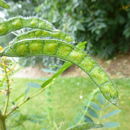ar
الأسماء في صفحات التنقل


Senna hebecarpa (lat. Senna hebecarpa) - paxlakimilər fəsiləsinin səna cinsinə aid bitki növü.
Senna hebecarpa (lat. Senna hebecarpa) - paxlakimilər fəsiləsinin səna cinsinə aid bitki növü.
Senna hebecarpa, with the common names American senna[3] and wild senna, is a species of legume native to eastern North America.[2][1][4] [5]
Senna hebecarpa grows as a sparsely branched perennial plant. It has alternate, compound leaves.[6]
Clusters of light yellow to orange flowers bloom from July to August in North America.[6]
The plant is found from the Great Lakes region and Maine southwards through the Eastern United States, in the Appalachian Mountains and Atlantic Plains, to Georgia.[2][7]
It is found in moist open woodlands, and in disturbed areas.[7]
It is a larval host and nectar source for the Cloudless Giant Sulphur (Phoebis sennae) butterfly.[6] It is also of special value to native bumble bees.[6] [8]
It is endangered in Massachusetts and New Hampshire, threatened in Vermont, as historical in Rhode Island,[9] and as threatened in Connecticut.[10]
Senna hebecarpa is cultivated as an ornamental plant, for use as a perennial wildflower and flowering shrub in traditional and wildlife gardens, in natural landscaping projects, and for habitat restoration projects.[6][4][5]
The Cherokee use an infusion of the plant for various purposes, including taking it for cramps, heart trouble, giving it to children and adults as a purgative and for fever, and taking it for 'blacks' (hands and eye sockets turn black). They also give an infusion of the root specifically to children for fever. They use a poultice the root for sores, and they use a compound infusion for fainting spells. They also use a compound for pneumonia.[11] The Iroquois use the plant as a worm remedy and take a compound decoction as a laxative.[12]
Senna hebecarpa, with the common names American senna and wild senna, is a species of legume native to eastern North America.
Senna hebecarpa est une espèce de plantes dicotylédones de la famille des Fabaceae, sous-famille des Caesalpinioideae, originaire d'Amérique du Nord.
Ce sont des plantes herbacées vivaces pouvant atteindre 2 m de haut.
La plante est parfois cultivée comme plante ornementale. Dans le Nord-Est des États-Unis, l'espèce est classée comme menacée ou en danger d'extinction, principalement du fait de la perte d'habitat[5].
L'aire de répartition originelle de Senna hebecarpa s'étend dans l'est des États-Unis dans les États suivants : Alabama, Caroline du Nord, Illinois, Kentucky, Tennessee, Vermont, Wisconsin[6].
Cette espèce se rencontre généralement dans des sites perturbés, dans les prairies humides, les pâturages, les champs cultivés ou sur les bords de routes, et en particulier dans le lit majeur des cours d'eau. Elle prospère en plein soleil ou dans des situations partiellement ombragées. Bien qu’elle préfère les sols humides, elle pousse également sur des terrains secs[5].
Selon Tropicos (11 octobre 2018)[1] (Attention liste brute contenant possiblement des synonymes) :
Senna hebecarpa est une espèce de plantes dicotylédones de la famille des Fabaceae, sous-famille des Caesalpinioideae, originaire d'Amérique du Nord.
Ce sont des plantes herbacées vivaces pouvant atteindre 2 m de haut.
La plante est parfois cultivée comme plante ornementale. Dans le Nord-Est des États-Unis, l'espèce est classée comme menacée ou en danger d'extinction, principalement du fait de la perte d'habitat.
Senna hebecarpa là một loài thực vật có hoa trong họ Đậu. Loài này được (Fernald) H.S.Irwin & Barneby miêu tả khoa học đầu tiên.[2]
Senna hebecarpa là một loài thực vật có hoa trong họ Đậu. Loài này được (Fernald) H.S.Irwin & Barneby miêu tả khoa học đầu tiên.